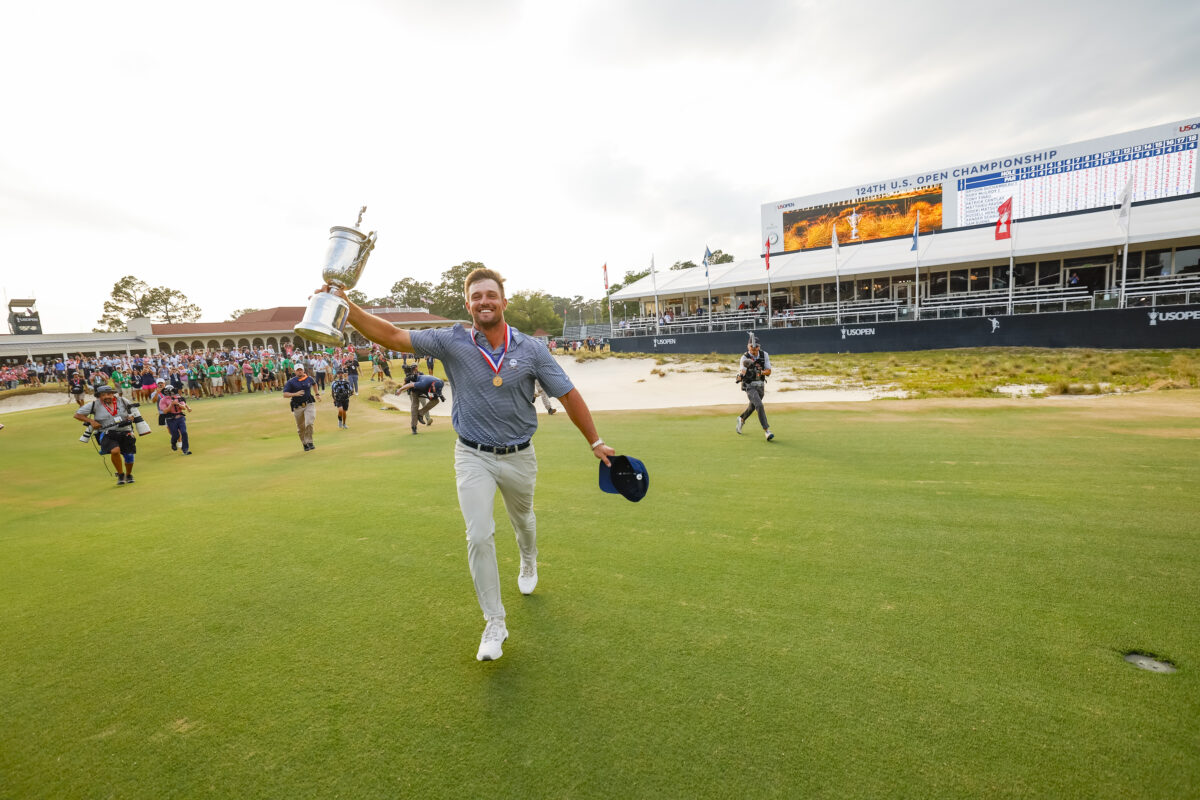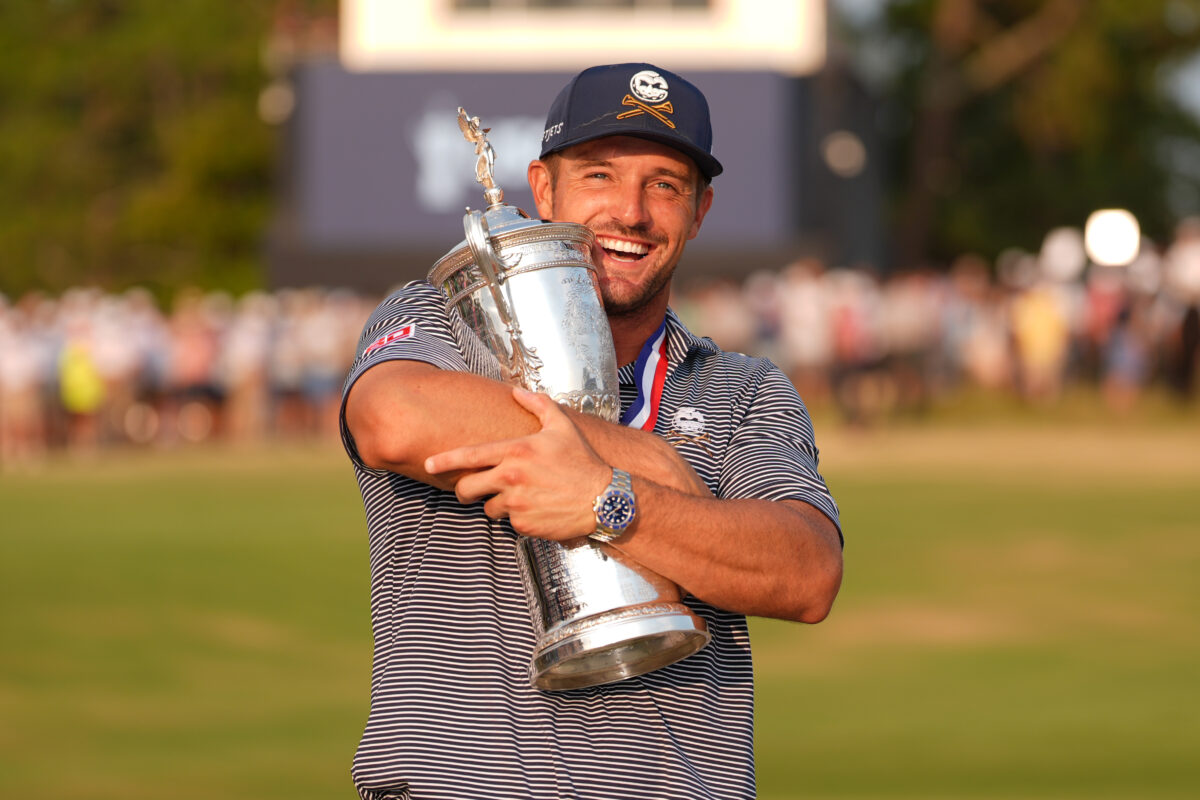Mike Schy wants to be clear — he hated posting the news that the Central Valley Jon DeChambeau Memorial Junior Tour, “where champions play,” would be closing its doors due to a “lack of funding.” But from his perspective, he could no longer wait for his longtime pupil, Bryson DeChambeau, who he said reneged on underwriting the cost of the tour, to step up and do what he felt was the right thing.
“Bryson has decided this was not a priority to him, offering only to loan money to his father’s namesake,” Schy, 63, wrote in his official statement online.
Reached via phone on Tuesday night as he walked his dogs, rescues from China and Turkey, he told Golfweek he stalled for three weeks before posting his official statement on social media.
“I had to post that. I’m a little pissed. I’m a little salty for a number of reasons, one of which is he made me look bad again,” Schy said.
DeChambeau, who often has referred to Schy as “a second father,” says he hasn’t worked with Schy since 2018 and paid him nearly $1 million for his prior services. He now called Schy a “disgruntled employee” and he and his agent have charged the coach with trying to extort $2 million after DeChambeau won the U.S. Open last month.
“It’s a complete and utter lie, all of it,” DeChambeau said in a phone conversation with Golfweek on Wednesday. “It’s a disgruntled former employee, unfortunately, and it is what it is. We’ve had numerous conversations and it hasn’t worked out from a business standpoint.
“It’s quite disappointing how he’s turned this and spun this. It’s a non-recourse loan that was going out. I gave him my dad’s name, image and likeness for free on the assumption we’d have a good business plan and it just hasn’t worked out. I’m going to be doing a lot for my community, just in a different fashion with a proper business plan and done correctly.”

“I’m at a high point right now and I’m a big character right now and I’m trying to do what’s right for the game of golf and you’re trying to bring my image down to hurt the game of golf essentially,” DeChambeau said. “This just ain’t a story, it’s a disgruntled employee, my friend.”
It’s a sad tale, but it must be told.
DeChambeau, Schy teamed up on events
A year and a half ago, Schy and DeChambeau were talking when Schy expressed his disappointment at how junior golf tournaments had priced many of his students out of the market. DeChambeau, who grew up in Clovis, California, and learned the game under Schy’s watchful eye at the Mike Schy Golf Performance Institute at what is now known as Dragonfly Golf Club in Madera, a suburb of Fresno, didn’t have the financial support to play a national schedule of junior tournaments. Schy figured there were about 14 affordable events for DeChambeau to choose from in the Fresno area that helped him cut his teeth.
“They are all gone,” Schy lamented. “The one or two we have charge entry fees in the neighborhood of $200.”
Schy suggested to DeChambeau that they team up to do something to fill the void. DeChambeau nodded in agreement and listened. Schy said he thought DeChambeau understood that it was the right thing to do for their community. When Schy proposed naming it the Bryson DeChambeau Junior Tour, DeChambeau had a better idea.
“Let’s name it after my dad,” he said.
Last summer, Schy did a test run at Madera Country Club, attracting 70 kids between the ages of 12 and 18 and charging $60. DeChambeau did a welcome video for the inaugural event. It worked well enough that Schy did a few more events at other local country clubs. In September, DeChambeau asked him how much he needed for the second year. According to DeChambeau, Schy asked for $125,000 for two years to get the tour off the ground. (A draft of a line of credit document from DeChambeau’s camp indicates the actual amount was $130,000.)
Schy described the amount for DeChambeau as being equivalent to his coach dipping into his wallet and giving $3.
“I know Bryson and I knew he didn’t really want to give the money and I certainly knew he didn’t want to give it for a long period of time,” Schy said.
At their next meeting, Schy said DeChambeau, who fronted the cost of creating the 501-C3 foundation, told him he isn’t a fan of non-profits and he needed to make money off the tour. Schy said DeChambeau agreed to give the money but as a non-recourse loan for the tour, adding he wouldn’t need to repay the loan.
“What does that even mean?” Schy asked. “It was the stupidest thing I’d ever heard.”
DeChambeau claims he was never presented a viable business plan, and DeChambeau’s agent, Brett Falkoff, a vice president in the golf division at GSE Worldwide, contends that the 501-C3 was set up incorrectly in the state of California and DeChambeau never signed any official paperwork.
“It is our understanding that initially, they had only filed the certificate of incorporation (not attached) with the California Secretary of State and had not prepared bylaws or any other organizational documents. After requesting copies of the bylaws, it appears they then prepared some form bylaws and sent the attached bylaws to Connor Olson [DeChambeau’s manager]. The bylaws provided were not consistent with the stated intent of the Tour and would not have been adequate to support the proposed Tour activities. At that point, Bryson authorized his personal attorney to prepare bylaws that were consistent with the stated purposes of the Tour and would permit the Tour to function as intended,” Falkoff wrote in an email. “The new bylaws were prepared, at Bryson’s expense, and were completed sometime in June along with the Line of Credit Note that would have allowed Bryson to fund the Tour’s initial operations. Once the revised bylaws were approved and executed, there were a few additional resolutions that would have been prepared related to the makeup of the board of directors and authorizing the signing of the note.
“It did not appear that an attorney was consulted about the process for forming the new entity, which is why the cleanup was necessary. It would have been irresponsible for Bryson to advance money to the Tour entity prior to getting the proper documentation completed and signed.”
Receipt of the certificate to Olson was received on March 6. A month later, they requested bylaws and other required documents from Schy and his fellow board member Brandon McQueen. On June 5, DeChambeau’s lawyer reviewed and prepared the revised bylaws and six days before he won the U.S. Open, a line of credit to facilitate the funding had been prepared.
Schy was planning on doing four or five junior tour events this year, but once DeChambeau started ignoring him he grew more concerned about how he could keep the tour afloat. He sought other means to do so but those fell through, too. Tournaments were scheduled to begin in mid-June and parents started wondering what was going on. Schy said he heard only from DeChambeau’s management. Falkoff confirmed that was the case and offered an explanation for the delay.

“Had Bryson not won the U.S. Open and a million things hadn’t come up that we’re trying to sort through maybe something would’ve gotten done a little quicker,” Falkoff said. “We still had all the documents. I told Mike to be patient and he decided not to be patient anymore. He decided to go nuclear.”
Schy, who said he was told “his bark was worse than his bite,” felt he had no choice but to close the doors and go public with the story.
“It was looking bad that I was the one who made it fail,” Schy said. “In the end, it was me because I was relying on Bryson to see this through and help us get this really rolling. I was very clear that we needed him to go to the next level.”
Schy had worked with DeChambeau — a nine-time winner on the PGA Tour, including the U.S. Opens in 2020 and 2024 — since age 11 and was on the bag when DeChambeau won the 2015 U.S. Amateur. Schy traveled as his instructor for his first three seasons on Tour before they had a blow-up at the 2018 PGA Championship and DeChambeau hired Chris Como, and more recently Dana Dahlquist. But while they may have stopped worked together in an official capacity, Schy said DeChambeau always called him when he was desperate for help.
Schy said he’s had others reach out, offering to help get the junior tour back on its feet, and he’s made it clear that he’s simply looking for around $65,000 per year – “not a million” – and had no designs of taking a hefty salary as the executive director. Schy did the leg work but had no intention of running the tour. He said he had a former tour operator lined up to run the events and insisted he’s simply looking to teach golf and give local golfers a place to learn to compete like DeChambeau had as a kid.
DeChambeau sees Schy’s motives for being involved in the junior tour differently.
“He was using his placement in regards to my dad’s name to leverage a junior tour to be created so he could bring more kids out to his place, which I don’t care about. All I care about is doing the right thing for the Central Valley, which is what I want to do and I will continue to do in numerous facets,” he said.
To hear Schy tell it, the amount of money he requested should be a drop in the bucket for DeChambeau, who previously confirmed signing a deal to join LIV Golf for more than $100 million. Forbes estimated he earned $44 million last year alone, not to mention the $4.3 million for winning the U.S. Open last month. On this point, DeChambeau didn’t disagree.
“I can give that money tomorrow,” DeChambeau said. “The point is I want to make it sustainable. I don’t want to be divvying out money and giving it away fruitlessly. He said I hate non-profits, no, I said I hate the way they are usually run. That’s what I actually said. Everything I said is misconstrued and twisted in a way that is absolutely false.”
Schy has a pretty good idea — in his mind anyway — why DeChambeau backed out of the deal.
“Because it was me that was the problem. It could’ve been $10 and he still would’ve said I’m going to need to loan it to you. That’s really sad. All I ever did was help him no matter what.
“All I can say is I did an awful lot for that kid. Being on pins and needles for the last seven years, dude has literally almost killed me, and most of which was to protect him. I know some of the worst stuff imaginable, and now they know that my bite is a little bit worse than my bark. All he had to do was be a decent person and take care of the junior tour.”
Schy pointed out that this wasn’t the first time DeChambeau has had second thoughts on a deal they had agreed to. Schy said his original contract as DeChambeau’s coach paid him 10 percent for a win and after DeChambeau won the 2017 John Deere Classic he determined that was too much. When Schy reminded him he didn’t get paid at all when DeChambeau missed 14 straight cuts, DeChambeau shot back that he had paid his expenses.
“I don’t remember you paying my bill from PG&E,” Schy said.
Falkoff confirmed amendments to the contract were later made. Also, he noted that DeChambeau paid $450,000 for a down payment on Schy’s home in 2018. [Schy said DeChambeau loaned him $100,000 that he paid back as soon as the house closed.]
Schy also said that DeChambeau reneged on a deal to pay him $60,000 per year for the rest of his life after just six months, an agreement Falkoff said never reached paper. But DeChambeau’s memory of his arrangement with Schy is plenty sharp. Off the top of his head, DeChambeau quoted that he paid Schy a total of $959,000 while in his employ. [Schy said that figure is inflated and assumes it must include travel expenses, which would not count as income.]

U.S. Open snub damaged relationship
The hurt Schy feels runs deeper than money and it rose to the surface after DeChambeau won the U.S. Open and failed to mention him as he thanked various people during his winner’s press conference.
“If he would’ve just been nice enough to give me some credit I would just be thankful to be part of the deal,” Schy said, “but to ghost me, ignore me, and deliberately not mention me? This soaking balls in Epsom salt — he was asked, ‘How did you come about this?’ And you don’t talk about me at that point? It’s purposeful and calculated. Who do you think shows him all this stuff?”
Take, for instance, DeChambeau’s prized Krank driver, which he has credited for much of his success since putting it in his bag last summer after the British Open. Schy was getting his persimmon drivers refinished at Oughton’s Golf Repair in Carmichael, California, and store owner Doug Oughton happened to have a Krank driver sitting nearby as they talked about bulge and roll. Schy told DeChambeau about it and two days later, Schy had tracked down Lance Reader, the owner of Krank Golf.
“Three days later, he had a driver. Ten days later he shoots 61-58 (at LIV Greenbrier) and now his life has changed,” Schy said. “The only reason his life has changed is because he’s playing better golf. His whole world revolves around golf. If his golf is good, he’s good; if his golf is bad, he’s bad and everything in his world is bad. That is the essence of Bryson DeChambeau.”
In January, at the PGA Merchandise Show in Orlando, Schy boasted that DeChambeau would win at least one major this year and that the major champ had another trick up his sleeves that it was premature to talk about.
DeChambeau had struck up a friendship with Heisman Trophy-winning quarterback Tim Tebow, who read the Golfweek story and asked DeChambeau, “Is there anyone in the world that believes in you more than this guy? He’s saying you’re going to win a major this year. Is anyone else saying that?”
According to Schy, DeChambeau didn’t answer.
The world found out about DeChambeau’s bulge-and-roll irons at the Masters when he opened with 65 using a set of 3D-printed irons designed by a student of Schy’s named Tom Bailey, who took a trip from his home in England to Northern California to meet Schy in person. Bailey ended up staying in California and started a boutique clubmaking company named Avoda Golf out of the tent at Schy’s academy and, thanks to DeChambeau’s success, has expanded into a friend’s garage.
More: Bryson DeChambeau’s 3D printed irons have bulge. Learn what that means and what it might do
“I knew the driver was the first part and if we could get the irons rolling that was the final part. I knew there was something to it. It was just a matter if we can get it done in time,” Schy said. “I kept saying in January get the irons to the USGA now. Finally, Carter (Rich, senior director of equipment, rules and conformance at the USGA) sent the scans. They were non-conforming because of the 3D printing. It doesn’t layer so the plainer surface in the groove wasn’t smooth. All we had to do was smooth them out. That’s what Connor did on Monday at Augusta (to make them conforming).”
DeChambeau concedes that Schy gave him the initial connection to Krank Golf’s Reader but said he already knew him from his long drive days and developed that relationship on his own.
“I’ve said thanks numerous times for that (introduction). I went out to his tent and I’ve given lessons to the kids and been around,” DeChambeau said.
He also disputed Schy’s role in the irons, crediting Bailey for making them to DeChambeau’s exact specifications.
“I worked hard with him to build those irons, personally. Mike did not have input on those irons. I came up with the bulge-and-roll progression, personally,” said DeChambeau, emphasizing the final word of that sentence. “It didn’t work the first time. We came back with Tom and the second time it worked really well. He’s lying to you.”
More: Bryson DeChambeau playing Masters using 3D printed irons only approved by USGA on Monday
Schy has always been a straight shooter and the hurt in his voice has never been more pronounced as the words continue to pour from his mouth.
“You would’ve thought I would’ve been able to come to him and say, dude, I need $60,000 to $70,000 for the next few years to fund this tour. He should’ve said, ‘Are you sure that’s enough?’ I’m thinking, ‘Why am I begging for money for this?’ I was totally uncomfortable. I should’ve been able to ask for $1 million and him going, ‘It’ll be in the bank tomorrow.’ Instead, it’s gotta make a profit, it’s gotta be this, it’s gotta be that. How about we get it off the ground first and then we decide what it’s going to be? How about thanks, Mike, for starting my dad’s tour. Nope.”
“He said I’m his second dad, right?” Schy said. DeChambeau’s father died in 2022. “He treats me just like his real dad. He treated his dad like shit.”
‘I always tell Bryson don’t single out anyone’
DeChambeau’s public transformation into “the greatest showman” reached a crescendo on Sunday at the U.S. Open as he mugged for the cameras, slapped hands with fans and extended a chance for everyone to touch the silver trophy. But when DeChambeau listed off those members of his team that helped him and left out Schy, that was the last straw.
“I always tell Bryson don’t single out anyone individually, always mention the team,” Falkoff said. “Then you don’t have to worry about hurting anyone’s feelings; Mike’s feelings got hurt, that’s ultimately what led to all of this.”
Falkoff called Schy the night of the U.S. Open victory, as was his custom, and said he was upset about the slight. Two days after DeChambeau had won his second major, just as Schy predicted, the former coach was still fuming and, according to the agent, called with demands.
“Mike says, ‘It’s time that Bryson opens up his checkbook and I get paid. I want $2 million,’ ” recalled Falkoff. “I took that back to Bryson. He said, ‘I’m not paying him almost 50 percent of my U.S. Open winnings, that’s not going to happen. I’m willing to compensate him for help with Krank and Avoda but he’s not going to extort me for $2 million.’ ”
Schy didn’t dispute that he asked for $2 million. In fact, he said he had a list of demands including reinstating his $60,000-a-year contract for the rest of his life that he had been promised — with backpay — as well as an apology.
“If you’re not going to recognize anything that I’ve done for you then Mike Schy has to look out for Mike Schy,” he said.
On July 2, Schy received a compensation offer, which he termed “a few bucks,” and a Non-Disclosure Agreement to sign. “I was offended,” said Schy, who rejected the offer on July 4.
“Oh, $300,000 is offensive?” DeChambeau said when told of Schy’s reaction. “Really, for not working with him since 2018?”
DeChambeau said he tried to resolve the situation and called Schy’s response unfortunate.
“I’m trying to take care of it like a good man,” DeChambeau said. “It’s unfortunate that he’s had to go to this position to try to take me down. You know what? It is what it is. It’s not true though, not one bit of it.”
There has been one other innocent bystander in this ugly breakup — David Schy.
“He fired my son, who he’s known for 20 years, who was building a putting green in his backyard,” Mike Schy said. “He’s mad at me, doesn’t even tell my son that he’s firing him.”
“We needed a clean split,” explained DeChambeau, who did so on July 5, after paying David for all his materials and anything outstanding at the time. “Having any ties to him after trying to extort me was necessary.”
Schy conceded that this breakup with his former prized pupil has taken its toll on him in the last six months.
“More than I thought it would,” he said, “and he doesn’t give a rip about it, which again, that’s exactly how he treated his real dad.”
“You know how he could fix this? He could make a call to me and say he’s going to fund it, keep the tour running and put out a statement that he made a mistake and he’s sorry. Then everyone would say he’s really changed. But that ain’t going to happen. Because it’s me. I don’t know what it is within him that he hates me so much and yet whenever he truly needs something that everyone is going to make fun of he always calls me. I wish I could figure that out. I’ve talked to people who understand what a narcissist is.
“You think he’s ever called me to just to see how I’m doing? He’s never done that. Never asked how the business is going. I had to understand what that is. I thought I can take it but I didn’t know I couldn’t. You can only be called the names I’ve been called so many times.
“Do you know how many times he told me I don’t know shit?” Schy said, taking a pause after finishing his dog walk. “I’m through being on pins and needles. No more.”
The question still remains: Why didn’t DeChambeau mention Schy’s role in his success? Was it really calculated?
“I forgot my trainer,” DeChambeau said when posed the question of why he left out Schy. “I had a lot of people to mention and I’m sorry for it but at the same point in time trying to go out and extort someone for $2 million is a lot worse than forgetting to say thank you to somebody. We could’ve had an easy discussion about this but instead, he called my agent in a frantic, asking for $2 million. So you make the choice of what you think is really going on. All I have to say is I paid the guy close to a million dollars and I think you can read the room pretty well in this situation. He’s clearly reaching out to demolish me and that’s not going to happen.”
It will take more than a phone call between the two to patch this relationship up but that might be a good place to start. After all, this is a classic tale with three sides to the story: there’s Schy’s version, DeChambeau’s version and somewhere is the truth.
“There’s a lot more to this and I don’t know what to say,” Schy said, knowing he’s already said enough.
Asked how he thinks DeChambeau will fare at the British Open next week, Schy didn’t hesitate.
“He’ll probably win it,” he said.
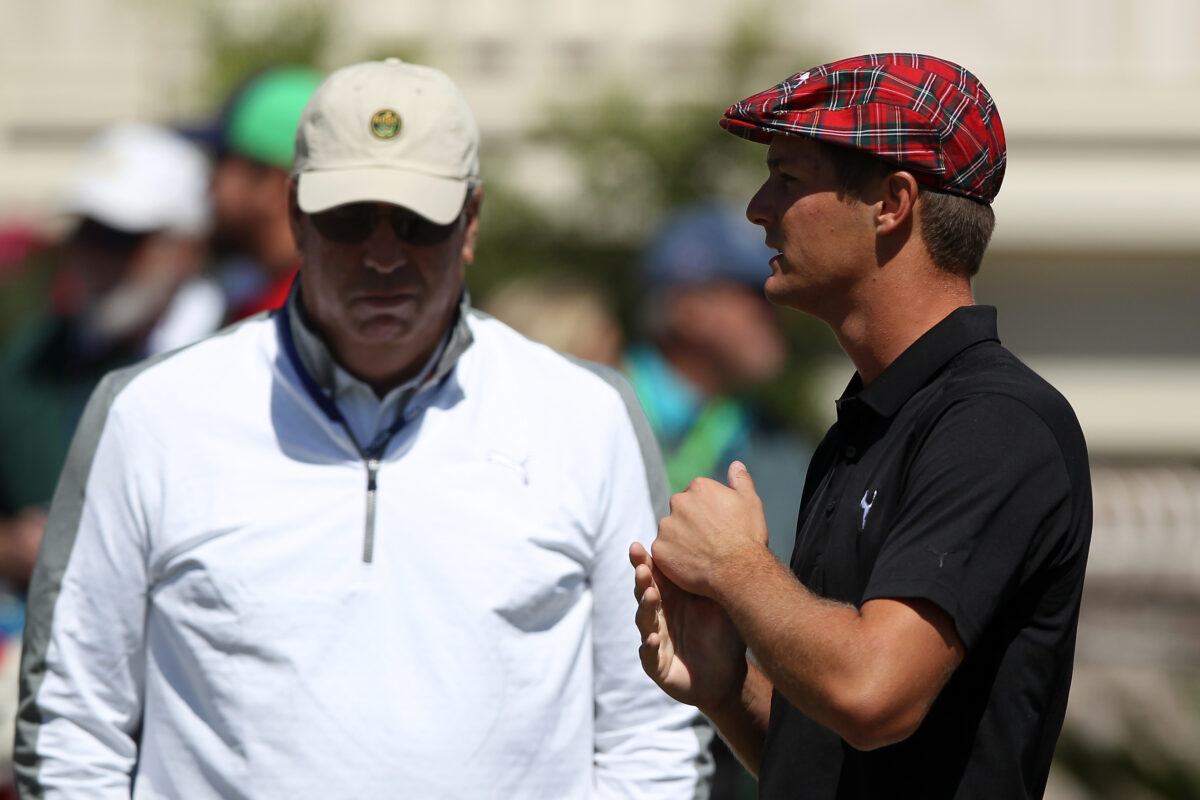
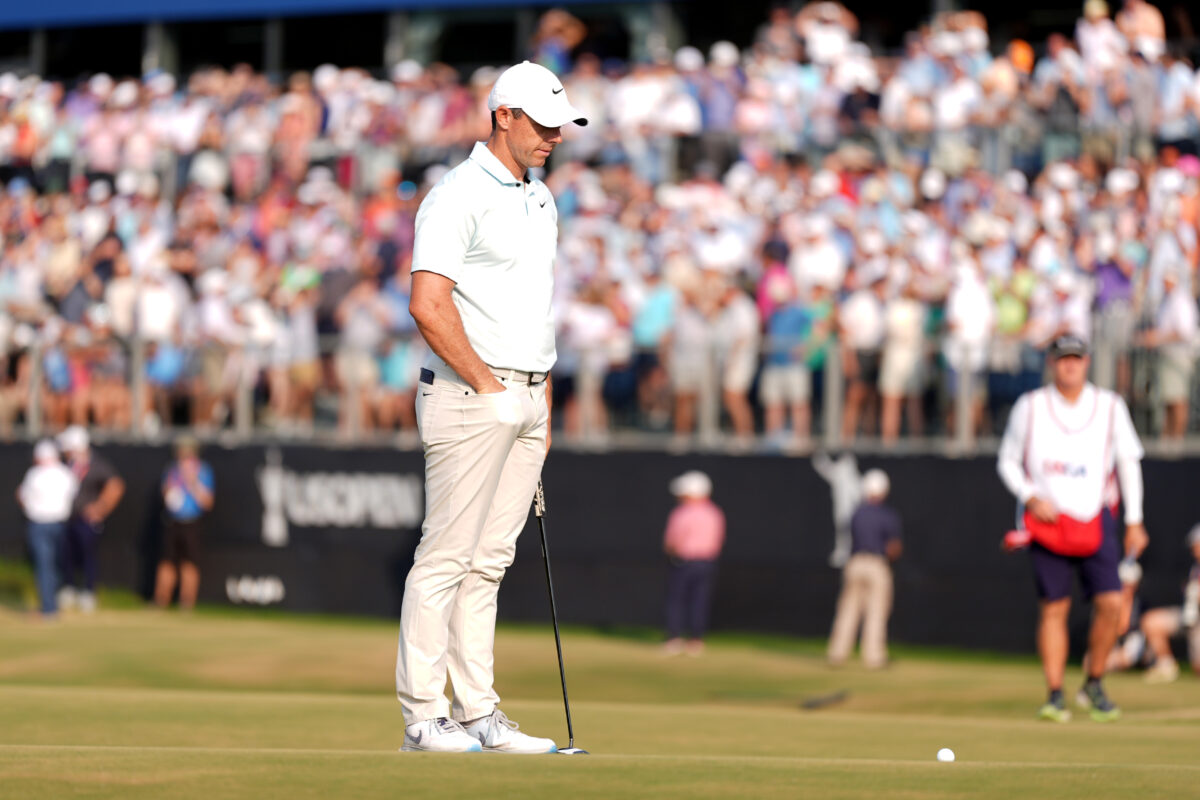

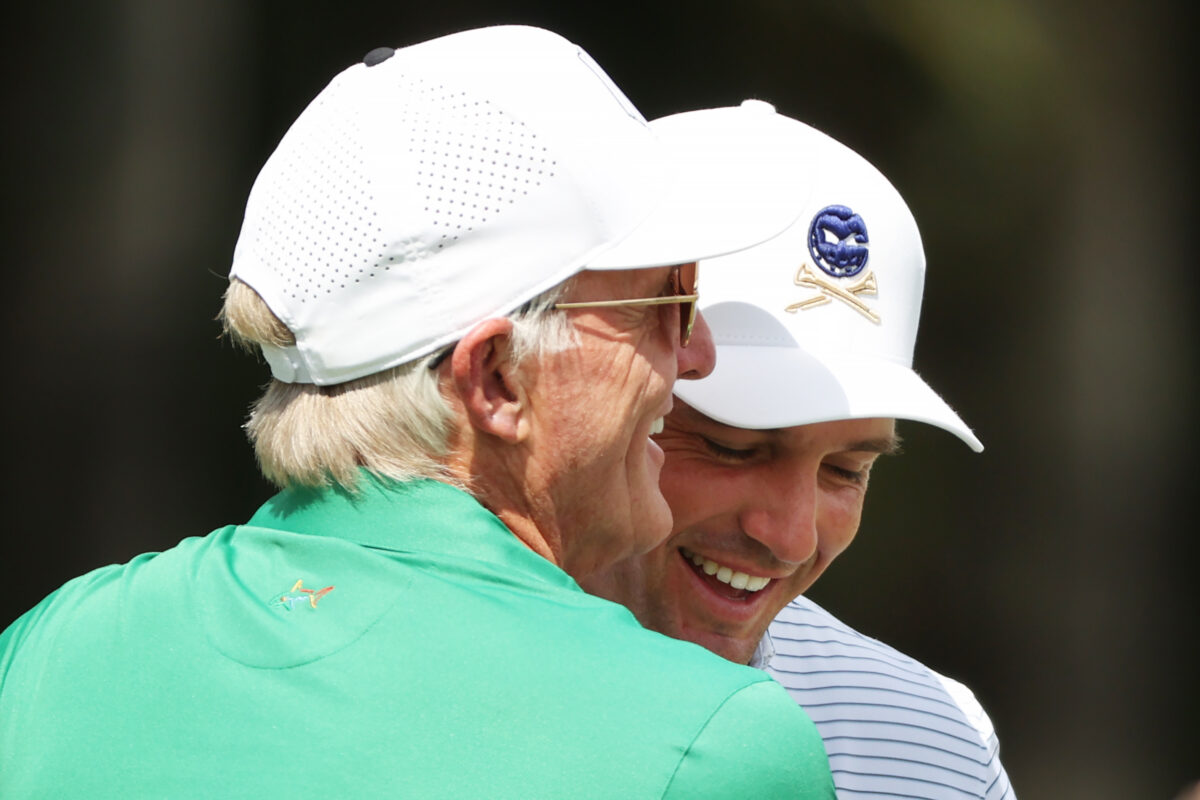


 LIV Golf CEO Greg Norman raises the U.S. Open trophy
LIV Golf CEO Greg Norman raises the U.S. Open trophy





